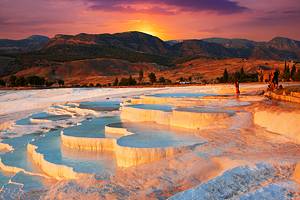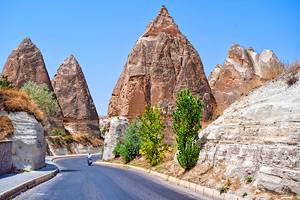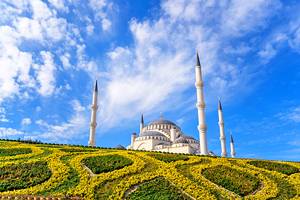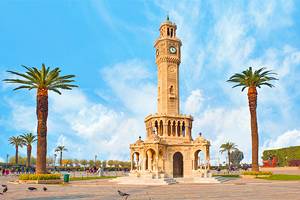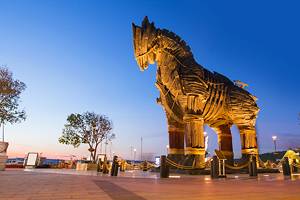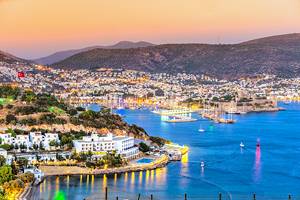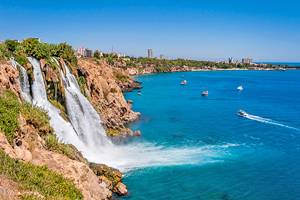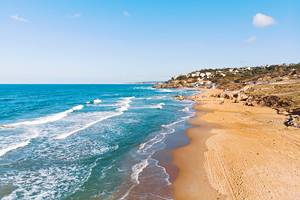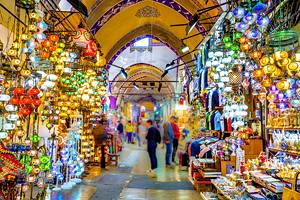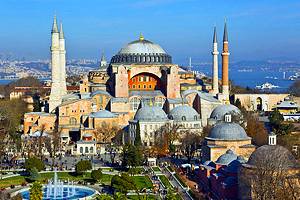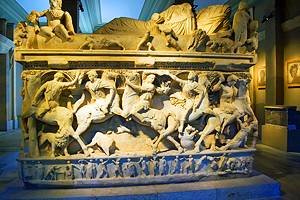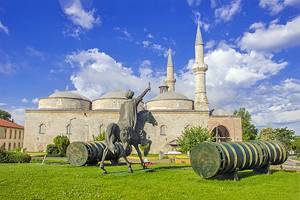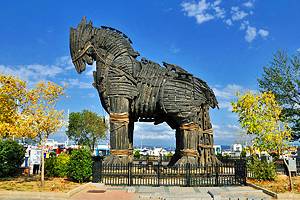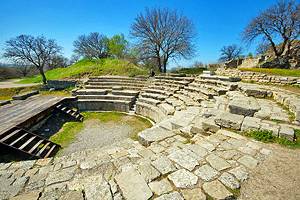Tourist Attractions in Istanbul
Author Jess Lee has been a regular Istanbul visitor for twenty years and used to run tours in the city. She lives in Turkey.
Coveted by empires across the centuries, straddling both Europe and Asia, Istanbul is one of the world's great metropolises.
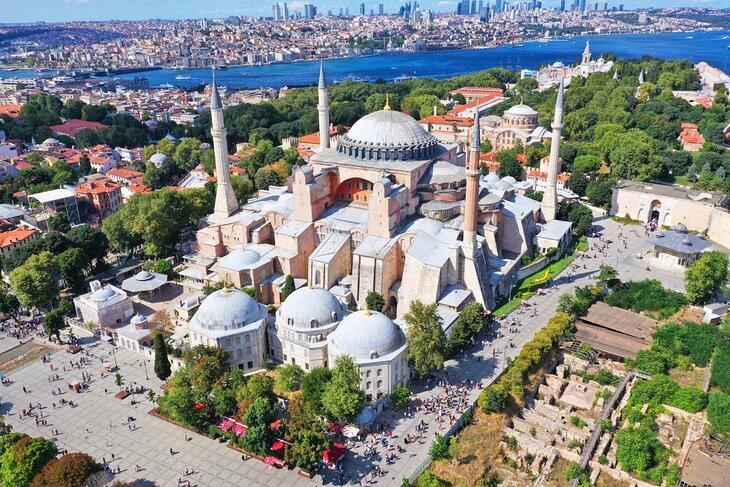
Founded around 1000 BCE, the colony of Byzantium grew into the Byzantine Empire's great capital of Constantinople and after the Ottoman conquest of the city, retained its glorious place as the heart of their empire.
The city (officially renamed Istanbul after the founding of the Turkish Republic) is liberally scattered with glorious remnants of its long and illustrious history, and the tourist attractions here will impress even the most monument-weary visitor.
As well as the big four (the Hagia Sophia Mosque, Topkapı Palace, the Blue Mosque, and Grand Bazaar), leave enough time to explore the other sights.
Although many of the most popular and best places to visit are located in, or near, the old city district of Sultanahmet, there is a dazzling array of other things to do throughout the farther reaches of the city.
Plan your trip with our list of the top attractions and things to do in Istanbul.
- Admire the Hagia Sophia (Aya Sofya) Mosque
- Explore Topkapı Palace (Topkapı Sarayı)
- Visit the Blue Mosque (Sultan Ahmet Cami)
- Head Underground at the Basilica Cistern (Yerebatan Sarnıçı)
- Stroll the Hippodrome
- Check Out the Collection in Istanbul Archaeology Museum
- Shop in the Grand Bazaar (Kapalı Çarşı)
- Admire the Architecture of the Süleymaniye Mosque
- Sample Turkish Produce in the Spice Bazaar (Mısır Çarşısı)
- Soak Up the Splendor of Dolmabahçe Palace
- See the Frescoes of the Chora Church (Kariye Cami)
- Visit the Museum of Turkish and Islamic Arts (Türk ve Islam Eserleri Müzesi)
- View the Little Aya Sofya (Küçük Aya Sofya)
- Admire the Tilework of the Rüstem Paşa Mosque
- Walk the Ramparts of Yedikule Fortress (Yedikule Hisarı)
- Climb up Galata Tower
- Cruise the Bosphorus Strait
- Take in the Art at Istanbul Modern
- Visit the Historic Fatih Mosque
- View the Pera Museum's Ottoman-Era Art
- Stroll Istiklal Caddesi and Taksim
- Explore the District of Üsküdar
- Map of Tourist Attractions & Things to Do in Istanbul
- Istanbul, Turkey - Climate Chart
Admire the Hagia Sophia (Aya Sofya) Mosque
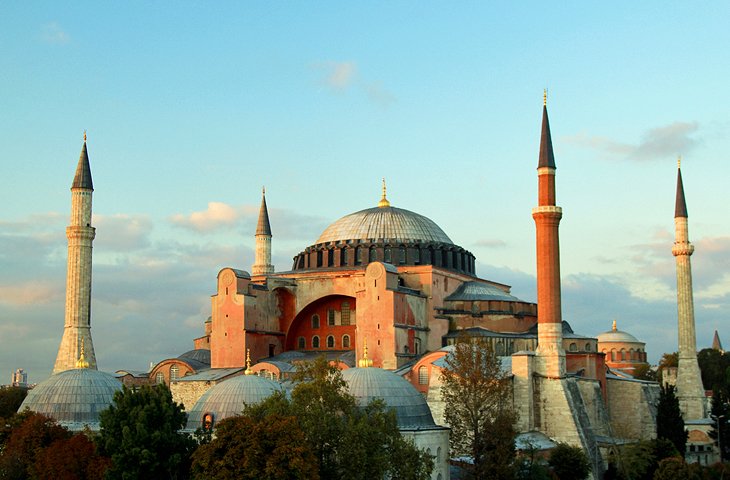
Highlights: Ancient architecture, deep religious significance, and glittering mosaics
It's said that when the Byzantine Emperor Justinian entered his finished church for the first time in CE 536, he cried out "Glory to God that I have been judged worthy of such a work. Oh Solomon, I have outdone you!"
The Hagia Sophia (Aya Sofya in Turkish) was the emperor's swaggering statement to the world of the wealth and technical ability of his empire.
Tradition maintained that the area surrounding the emperor's throne within the church was the official center of the world.
Through its conversion to a mosque, after the Ottoman armies conquered Constantinople, to its further conversion into a museum in the 20th century and its reconversion back into a working mosque in 2020, the Hagia Sophia has remained one of Istanbul's most cherished landmarks.
Address: Aya Sofya Meydanı, Sultanahmet
Explore Topkapı Palace (Topkapı Sarayı)

Highlights: Ottoman-era finery, sumptuous tilework, and the Harem complex
First built by Mehmet the Conqueror in the 15th century, glorious Topkapı Palace, beside the Bosphorus, was where the sultans of the Ottoman Empire lived and ruled from.
The vast complex is a dazzling display of Islamic art, with opulent courtyards lined with intricate hand-painted tilework, linking a warren of sumptuously decorated rooms, all bounded by battlemented walls and towers.
Of the many highlights here, the most popular are the Harem complex (where the sultan's many concubines and children would spend their days); the Second Court, where you can walk through the vast palace kitchens and stand in awe at the dazzling interior of the Imperial Council Chamber; and the Third Court, which contained the sultan's private rooms.
The Third Court also displays an impressive collection of relics of the Prophet Muhammad in the Sacred Safekeeping Room and is home to the Imperial Treasury, where you're greeted with a cache of glittering gold objects and precious gems that will make your eyes water.
To fully see Topkapı Palace, you'll need at least half a day.
Address: Babihümayun Caddesi, Gülhane Park
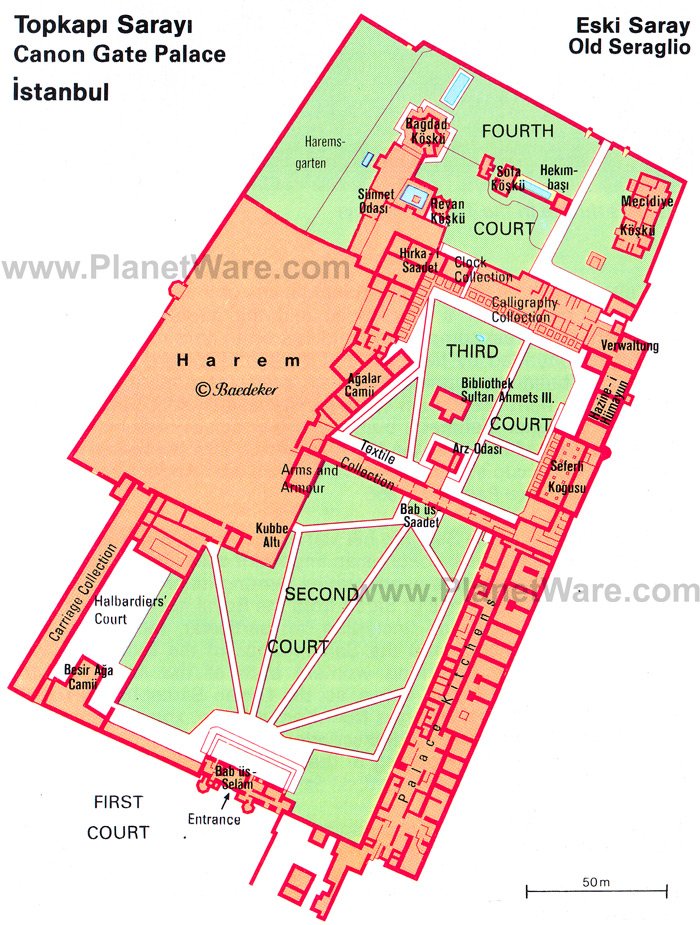

Visit the Blue Mosque (Sultan Ahmet Cami)
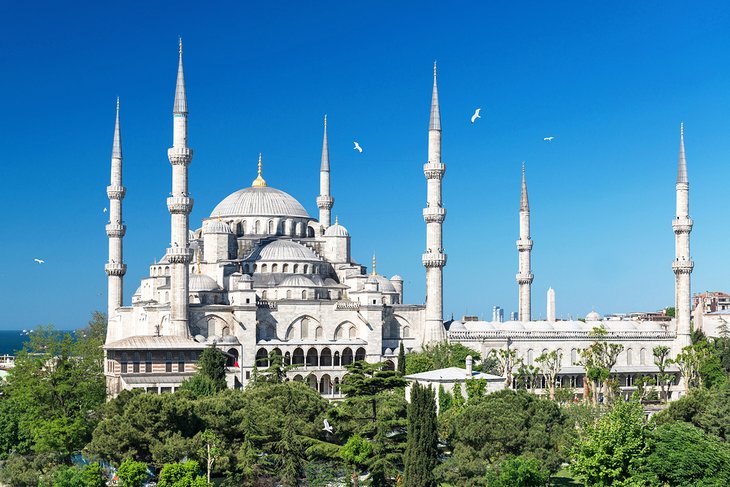
Highlight: Home to Istanbul's famed domed interior of Ottoman tilework
Sultan Ahmet I's grand architectural gift to his capital was this beautiful mosque, commonly known as the Blue Mosque today.
Built between 1609 and 1616, the mosque caused a furore throughout the Muslim world when it was finished, as it had six minarets (the same number as the Great Mosque of Mecca). A seventh minaret was eventually gifted to Mecca to stem the dissent.
The mosque gets its nickname from its interior decoration of tens of thousands of Iznik tiles.
The entire spatial and color effect of the interior makes the mosque one of the finest achievements of Ottoman architecture.
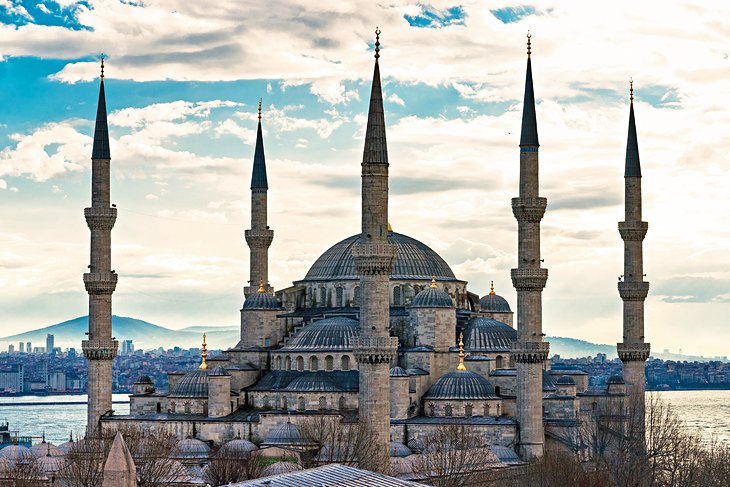
A great sightseeing joy of a trip to Istanbul is wandering amid the gardens sandwiched between the Blue Mosque and the Hagia Sophia to experience their dueling domes in twin glory.
Come at dusk for extra ambience, as the call to prayer echoes out.
Directly behind the Blue Mosque is the Arasta Bazaar; a great place for a shopping stop as the handicraft shops here sell high-quality souvenirs.
Even if you're not interested in a browse, head here to see the Great Palace Mosaic Museum, which is tucked between the Arasta Bazaar and the mosque.
This small museum displays the 250-square-meter fragment of mosaic pavement that was unearthed in the 1950s here. Excellent information panels explain the mosaic floor's recovery and subsequent rescue.

Head Underground at the Basilica Cistern (Yerebatan Sarnıçı)
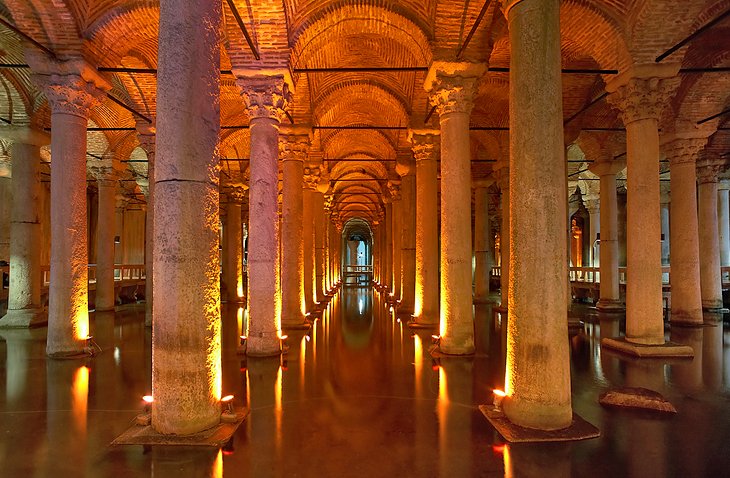
Highlight: Walking amid this atmospheric, majestic, and columned Byzantine-era space
The Basilica Cistern is one of Istanbul's most surprising tourist attractions.
This huge, palace-like underground hall, supported by 336 columns in 12 rows, once stored the imperial water supply for the Byzantine emperors.
The project was begun by Constantine the Great but finished by Emperor Justinian in the 6th century.
Many of the columns used in construction were recycled from earlier classical structures and feature decorative carvings.
The most famous of these are the column bases known as the Medusa stones in the northwest corner with their Medusa head carvings.
A visit here is very atmospheric with the columns beautifully lit and the soft, steady trickle of water all around you.
Address: Yerebatan Caddesi, Sultanahmet
Stroll the Hippodrome
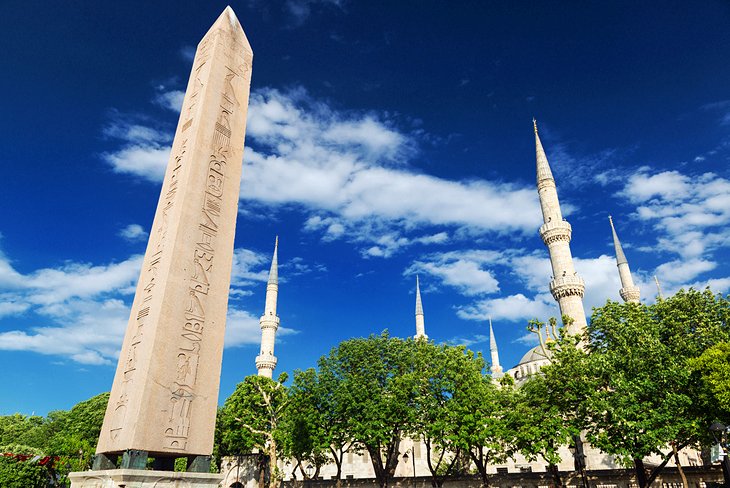
Highlights: Central park area holding relics from ancient Egypt and Greece.
The ancient Hippodrome was begun by Septimius Severus in CE 203 and completed by Constantine the Great in CE 330.
This was the center of Byzantine public life and the scene of splendid games and chariot races but also factional conflicts.
Today, there isn't much of the Hippodrome left to see, except for a small section of the gallery walls on the southern side, but the At Meydanı (park), which now stands on the site is home to a variety of monuments.
On the northwest side is a fountain, presented to the Ottoman sultan by the German Emperor William II in 1898.
Then, heading southwest are three ancient monuments: a 20-meter high Egyptian obelisk (from Heliopolis); the Serpent Column brought here from Delphi by Constantine; and a stone obelisk that originally was clad in gold-covered bronze plating until they were stolen by the soldiers of the 4th Crusade in 1204.
Check Out the Collection in Istanbul Archaeology Museum

Highlights: Viewing the Sidon necropolis collection, Anatolian sarcophagi, and the Tiled Pavilion
Just a hop, skip, and jump away from Topkapı Palace, and easily visited afterwards, Istanbul Archaeology Museum brings together an array of artifacts from both Turkey and throughout the Middle East, which sweeps through the vast breadth of history of this region.
There are three separate sections in the museum complex, each of which are worthy of a visit.
The Museum of the Ancient Orient displays a collection focused on the Middle East's pre-Islamic art and heritage.
The main Archaeology Museum houses statuary and tombs, including the famed sarcophaguses from Sidon, Lebanon that were unearthed by Ottoman architect Osman Hamdi Bey. Also here, you'll find the Istanbul through the Ages exhibit room, which helps you visualize the city's vast and epic history.
The museum's third building is the Tiled Pavilion, built by Mehmet the Conqueror, which houses a wide range of ceramic art.
Address: Osman Hamdi Bey Yokusu Sokak, Gülhane Park
Shop in the Grand Bazaar (Kapalı Çarşı)
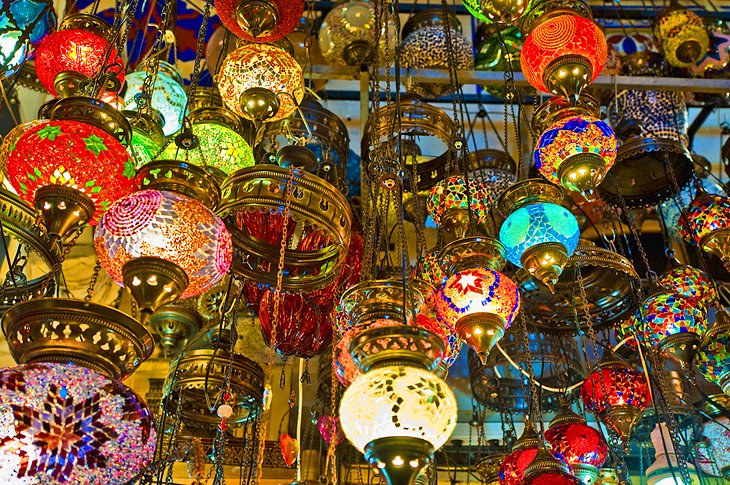
Highlight: One of the world's great shopping experiences
For many visitors, sightseeing in Istanbul is as much about shopping as museums and monumental attractions, and the Grand Bazaar is where everyone comes.
This massive covered market is basically the world's first shopping mall, taking up a whole city quarter, surrounded by thick walls, between the Nuruosmanıye Mosque and Beyazıt Mosque.
The Beyazıt Mosque (built in 1498-1505) itself occupies the site of Theodosius I's Forum and has architecture inspired by the Hagia Sophia.
Entrance to the bazaar is through one of 11 gates from where a maze of vaulted-ceiling laneways, lined by shops and stalls selling every Turkish souvenir and handicraft you could imagine, cover the area.
The various trades are still mostly segregated into particular sections, which makes browsing easier.
Near the bazaar's Divanyolu Caddesi entrance is the Burned Column. This stump (still 40 meters high) of a porphyry column was set up by Constantine the Great in his forum. Until 1105, it bore a bronze statue of Constantine.
Address: Divanyolu Caddesi
Read More: Istanbul's Grand Bazaar: Things to Buy & Shopping Tips
Admire the Architecture of the Süleymaniye Mosque
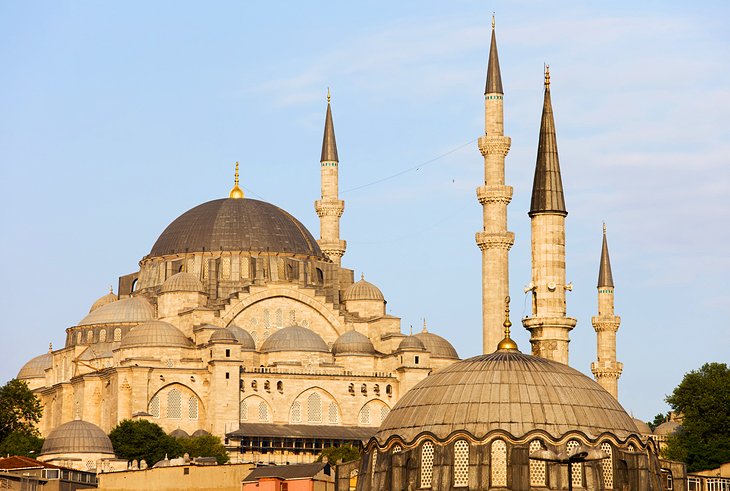
Highlights: Ottoman mosque architecture at its finest and the tomb of Sultan Süleyman I
Sitting high on the hill above Sultanahmet district, the Süleymaniye Mosque is one of the most recognized landmarks of Istanbul.
It was built for Sultan Süleyman I (commonly known as Süleyman the Magnificent; reigned 1520-1566) by the famed Ottoman architect, Sinan, who is responsible for many of the feted Ottoman-era monuments in Turkey including the Selimiye Mosque in Edirne.
The Süleymaniye Mosque's interior, dominated by its soaring 53-meter-high dome is notable for its harmonious proportions and unity of design.
Outside in the tranquil garden area is an interesting Ottoman-era cemetery, which is also home to the türbes (tombs) of the Sultan Süleyman and his wife Haseki Hürrem Sultan (often commonly known outside of Turkey as Roxelana).
Address: Professor Sıdık Sami Onar Caddesi
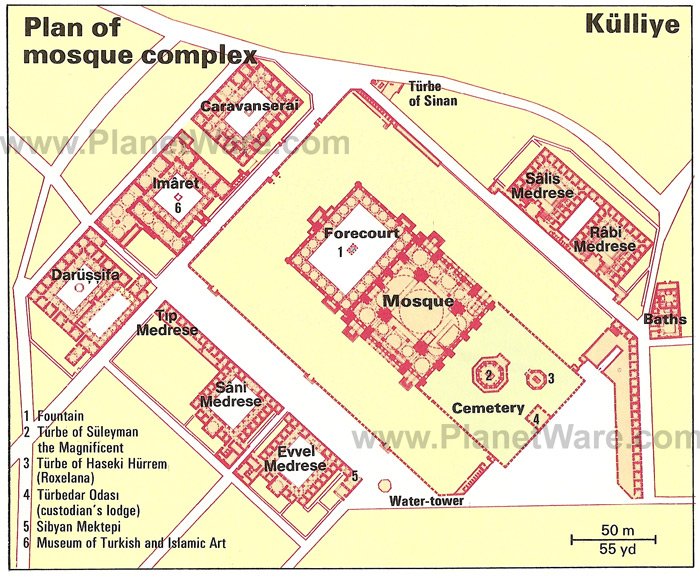
Sample Turkish Produce in the Spice Bazaar (Mısır Çarşısı)
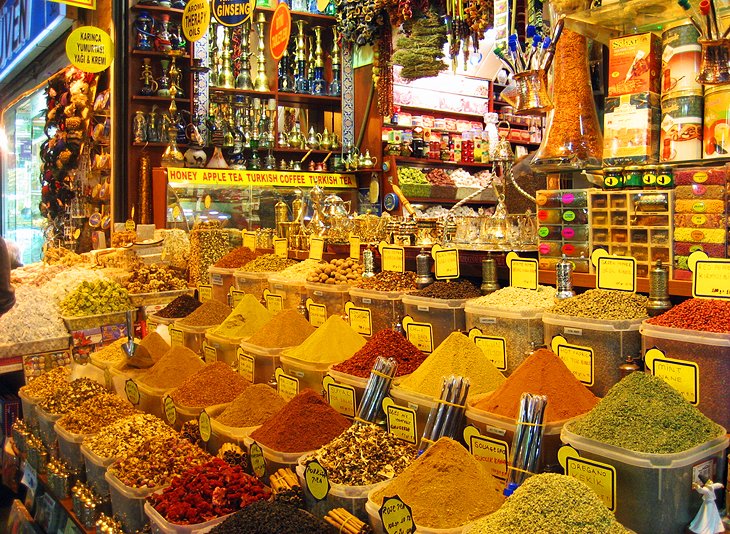
Highlights: One-stop-shop for Turkish flavors and sampling the country's famed sweet treats
The Spice Bazaar is the place to get your foodie fix of lokum (Turkish delight), dried fruit, nuts, herbs, and, of course, spices.
Much of the money that helped construct it came from the taxes the Ottoman government levied on Egyptian-made products, which is why its name in Turkish (Mısır Çarşısı) means "Egyptian Market."
The Spice Bazaar is one of Istanbul's most popular tourist attractions and at certain times of the day gets ridiculously crowded with huge tour groups from the docked cruise ships.
Try to come before 11am or after 4pm to dodge the crowds.
Just next door to the Spice Bazaar's main entrance is the stately Yeni Cami (New Mosque), which was begun in 1615 and finished in 1663 – that's "new" for Istanbul.
It is worthwhile taking a peek inside while you're sightseeing in the area, as the interior is richly decorated with tilework and liberal use of gold leaf.
Address: Yenicami Meydanı, Eminönü
Soak Up the Splendor of Dolmabahçe Palace
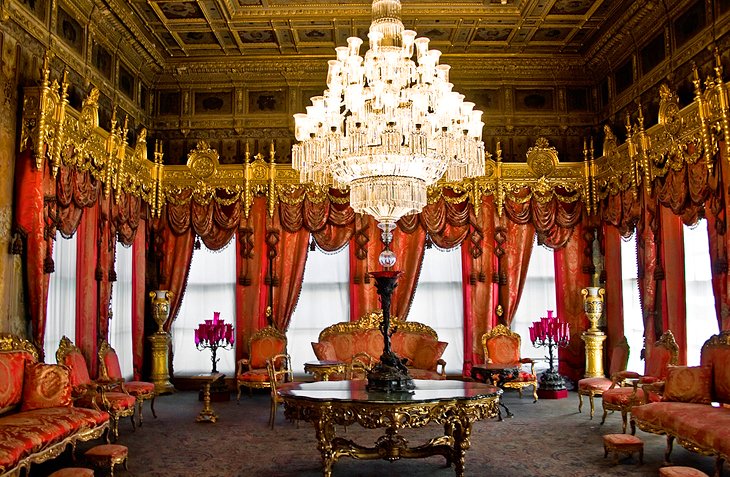
Highlights: Extravagant palace interiors and manicured formal gardens
The sumptuous and ornate Dolmabahçe Palace shows the clear influence of European decoration and architecture on the Ottoman Empire in the 19th century.
Built by Sultan Abdülmecid I in 1854, it replaced Topkapı Palace as the main residence of the sultans.
Dolmabahçe Palace was also used as an official residence during the founding years of the Turkish Republic, and Atatürk (the founder of modern Turkey) died here in 1938.
The formal gardens are punctuated with fountains, ornamental basins, and blooming flower beds.
Inside, the interiors blend Rococo, Baroque, Neoclassical, and Ottoman elements with mammoth crystal chandeliers, liberal use of gold, French-style furnishings, and frescoed ceilings to create a dazzling Turkish Renaissance style of sheer splendor and pomp.
Location: Dolmabahçe Caddesi, Besiktas

See the Frescoes of the Chora Church (Kariye Cami)
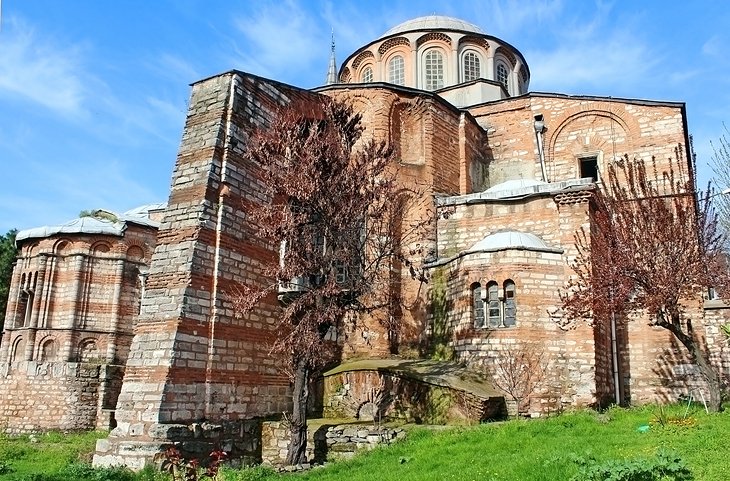
Highlight: Home to a famed collection of late-Byzantine-era frescoes and mosaics
Chora means "country" in Greek, and this beautiful Church (originally called the Church of St. Saviour of Chora) lay just outside old Constantinople's city walls.
The first Chora Church was probably built here in the 5th century, but what you see now is the building's 6th reconstruction as it was destroyed completely in the 9th century and went through several facelifts from the 11th to 14th centuries.
The church was turned into a mosque after the Ottoman conquest of Constantinople and became a museum in 1945. In 2020, it reconverted into a working mosque.
The monument is rightly world-famous for its fabulously vibrant 14th-century mosaics, preserved almost intact in the two narthexes and fragmentarily in the nave, and the frescos along the walls and domes.
These incredible examples of Byzantine artistry cover a wide range of themes, from the genealogy of Christ to the New Testament stories.
Location: Kariye Cami Sokak, Edirnekapı
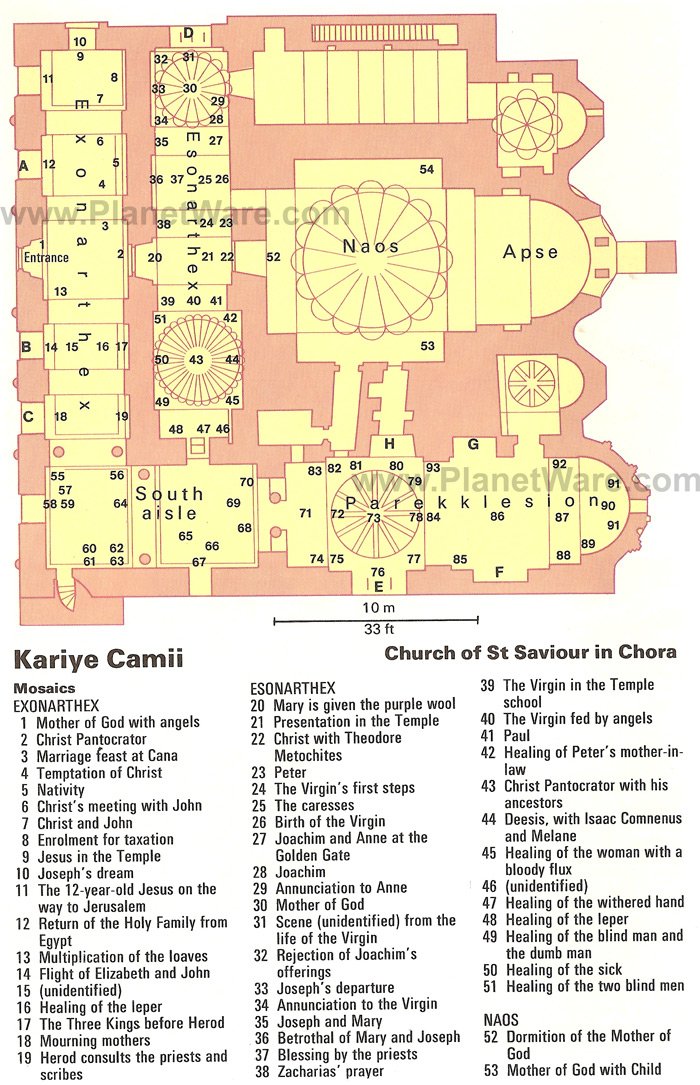
Visit the Museum of Turkish and Islamic Arts (Türk ve Islam Eserleri Müzesi)

Highlights: World-famous carpet collection; showcase of the wood, ceramic, and stone artistry of the Islamic empires
Housed in the palace of Ibrahim Paşa, who was Grand Vizier for Sultan Süleyman the Magnificent, the Museum of Turkish and Islamic Arts is a must-see attraction for anyone interested in Ottoman and Islamic art.
The carpet collection on display here is vast and is heralded by textile experts as the world's best.
This is a prime place to come have a peek at the dazzling array of styles of Turkish carpets (along with carpets from the Caucasus and Iran) across the centuries before setting out on a shopping mission to purchase your own floor piece.
There are also exquisite ceramics, calligraphy, and wood carving exhibits ranging in date from the 9th century CE to the 19th century.
Address: At Meydanı Caddesi, Sultanahmet
View the Little Aya Sofya (Küçük Aya Sofya)
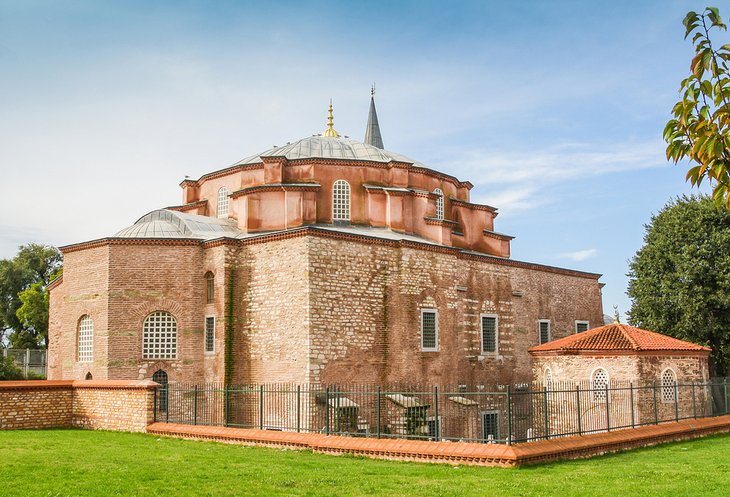
Highlight: Serene church-turned-mosque amid Istanbul's historic core
Before Emperor Justinian built the Hagia Sofia (Aya Sofya), he had to test out if the building would work structurally, so he built this miniature version first.
Its original name was the Church of Sergius and Bacchus, but the obvious architectural parallels with the Aya Sofya led to its long-held nickname becoming the building's official title.
During the Ottoman era, the church was converted into a mosque and it still functions as a working mosque today.
Although its proportions aren't as grandiose as others in Istanbul, the building has been beautifully restored and is well worth a visit.
The walk here, down narrow alleyways lined with tall Ottoman-era buildings – some lavishly restored and others creaking their way into dilapidation – is a tranquil respite from central Sultanahmet.
Take the time to have a glass of tea in the Little Aya Sofya's peaceful garden to sustain you for further sightseeing exploits.
Address: Küçük Aya Sofya Caddesi , Sultanahmet
Admire the Tilework of the Rüstem Paşa Mosque

Highlight: An interior of glorious and immaculately preserved ceramic tilework displays
Possibly the most perfectly pretty mosque in Istanbul, the Rüstem Paşa Mosque is home to the most stunningly preserved Iznik tile panels in the city.
Sure the Blue Mosque (Sultanahmet Mosque) may get all the glory, but it's here – covering both the exterior courtyard walls and the mosque interior itself – that you'll find the best examples of these gorgeously intricate hand-painted tiles in blues, reds, and greens.
Even better, as it's less known, you're likely to be able to admire them up close without having to battle any crowds.
Finding the mosque adds to the fun as it's squirreled down a skinny lane lined with market stalls and always bustling with life, near the Spice Bazaar.
Address: Hasırcılar Caddesi, Eminönü
Walk the Ramparts of Yedikule Fortress (Yedikule Hisarı)
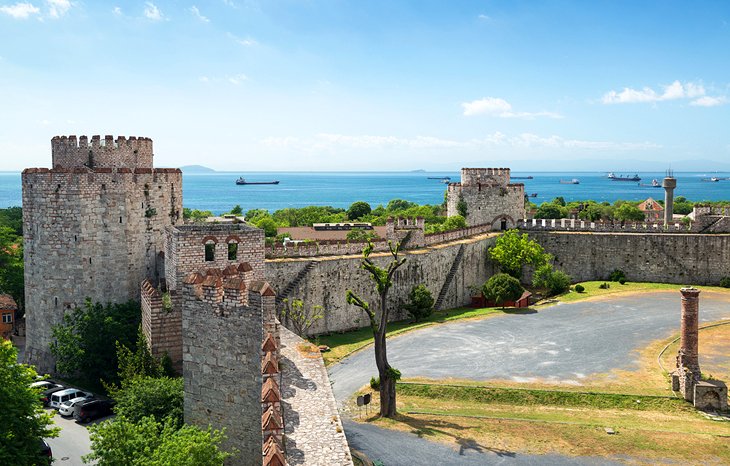
Highlight: Take in the sea views while strolling this preserved section of the city's Byzantine walls
Although it's a bit of a schlep on the suburban train to get out to Yedikule (Castle of the Seven Towers), this commanding fortress is well worth it.
Built in the 5th century by the Emperor Theodosius II, the fortress made up the southern section of Constantinople's defensive walls.
The mammoth arch (blocked up in the late Byzantine period) was known as Porta Aurea (Golden Gate), with doors plated in gold.
When the Ottomans conquered the city, they used the fortress for defense, and later as a prison and execution place.
Yedikule has been restored in recent years, and you can climb up to the top of the battlements for superb views across the Sea of Marmara.
Address: Yedikule Sokak, Yedikule
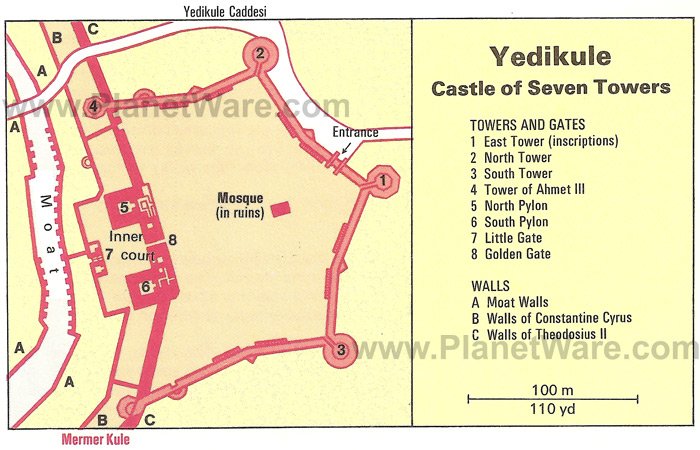
Climb up Galata Tower
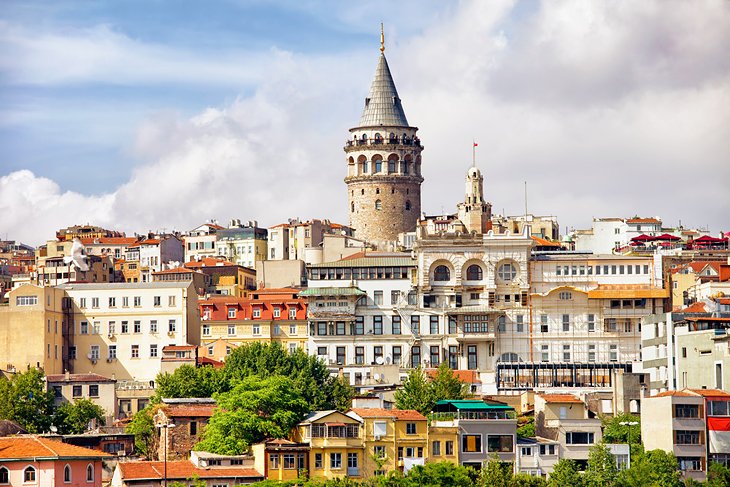
Highlights: Views of this landmark building from the surrounding narrow alleys, and vistas of the historic city center from the top
The Galata Tower, overlooking the Golden Horn, was built by the Genoese in the 14th century. Today it remains one of Istanbul's most recognizable landmarks.
Standing 52 meters tall, the tower was Istanbul's tallest building for centuries. The tower has been restored several times over the years due to being damaged by fire and storms.
Today the observation deck at the top story, and its restaurant, is one of the best places to visit in Istanbul for taking in the iconic skyline views of the central old city.
Be aware, though, that it's a super popular sight, so come early or be prepared to queue.
Address: Bereketzade, Beyoğlu
Cruise the Bosphorus Strait
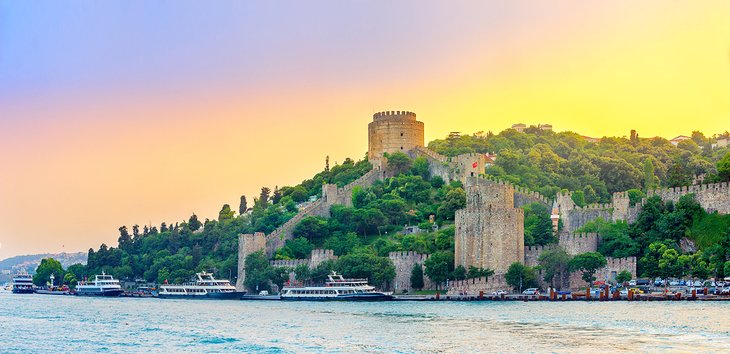
Highlights: Easygoing sightseeing and panoramic city views on one of the world's great straits
For many visitors, a trip to Istanbul isn't complete without hopping aboard a Bosphorus excursion ferry and cruising the city's famed waterway, which connects the Black Sea to the Sea of Marmara.
Istanbul's most iconic views are all from the water, and the Bosphorus excursion ferries are all about sitting back, relaxing, and taking in the scenery.
The most famous ferry tour is the Long Bosphorus Tour, which heads from Eminönü ferry dock daily, all the way up the strait to the village and fortress at Anadolu Kavağı, near the northern mouth of the strait into the Black Sea.
Along the ferry cruise there are shoreside vistas of defensive fortresses, Ottoman-era palaces and mansions, and the Bosphorus' bridges.
The Long Bosphorus Tour takes two hours one-way, stops in Anadolu Kavağı for three hours, and then returns, so you need to set aside a full day of your itinerary if you want to do it.
There is also a Short Bosphorus Tour option that operates daily two-hour afternoon sailings from spring to fall. This return ferry cruise heads up the Bosphorus as far as Rumeli fortress before turning around.
Take in the Art at Istanbul Modern
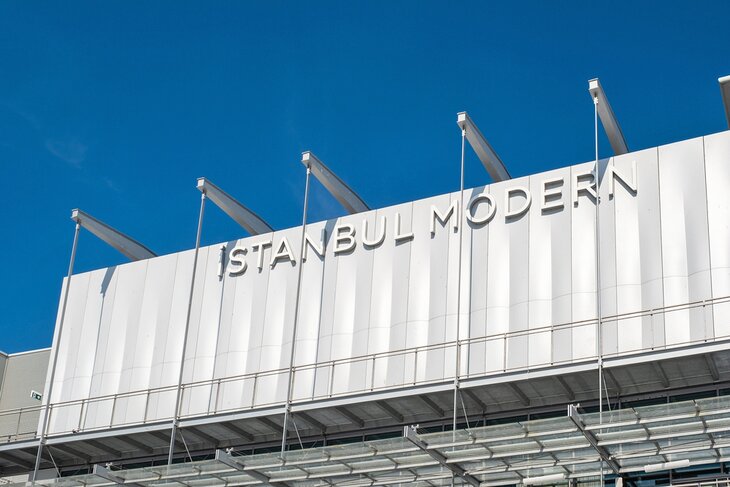
Highlights: Leading center for Turkish contemporary art plus trail-blazing temporary exhibitions
Proving that Istanbul isn't just about historic sightseeing, this thoroughly up-to-the-minute art gallery holds an extensive collection of Turkish modern art with an ever-changing calendar of exhibitions, hosting both local and international artists throughout the year.
This is by far the best place in town to get your finger on the pulse of Turkey's contemporary art scene.
As well as the galleries, the Istanbul Modern has a cinema that hosts a program of film viewings and a library.
The galleries are being temporarily hosted in a historic Beyoğlu building while they wait for the completion of this art museum's new permanent home in Karaköy.
Address: Mesrutiyet Caddesi, No:99, Beyoğlu
Visit the Historic Fatih Mosque
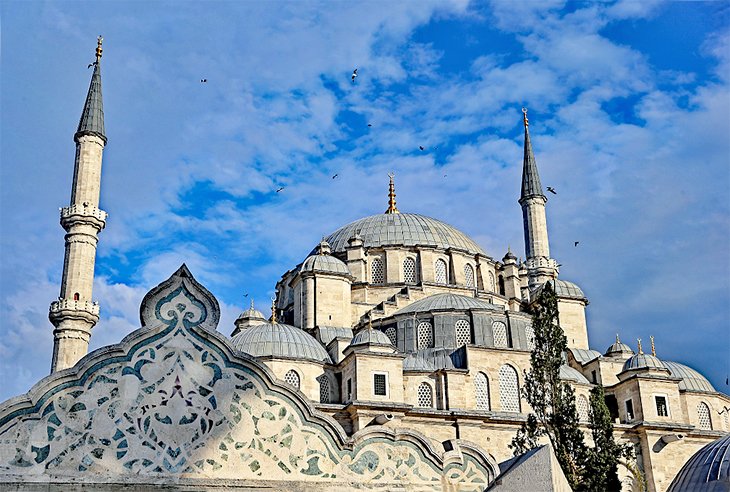
Highlights: Historic Ottoman-era mosque and site of Sultan Mehmet II's Tomb
The district of Fatih is home to this important mosque, which sits on the hilltop site of the first mosque built in the city by Sultan Mehmet the Conqueror, who finally broke through Constantinople's walls, ending the Byzantine era.
The original 15th-century mosque was badly damaged by an earthquake and so was replaced with this grand and imposing building, replete with multiple domes and minarets, in the 18th century.
Being the site of the first of Istanbul's grand imperial mosques to be built, as well as being home to Sultan Mehmet's tomb, it's an important historic building and a popular pilgrimage site.
Location: Fevzi Pasa Caddesi, Fatih
View the Pera Museum's Ottoman-Era Art
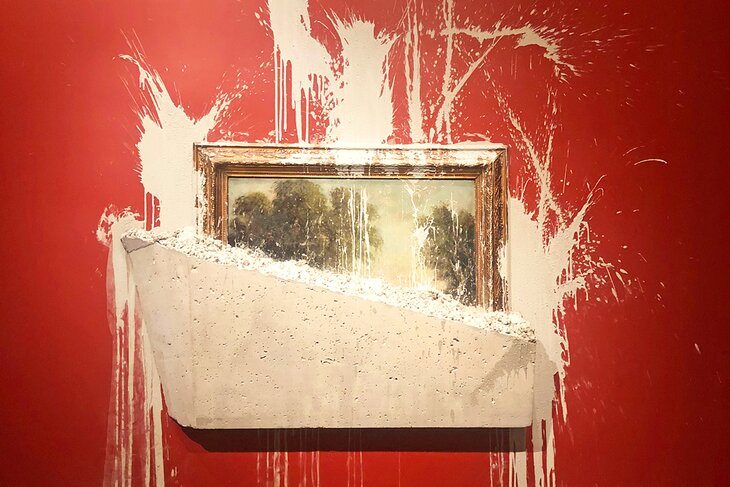
Highlights: Acclaimed collection of Orientalist art and world-class temporary art exhibitions
Istanbul's most famous art gallery is the lovely Pera Museum, which is where art-hounds head to view one of the finest collections of Ottoman-era art in the world.
In particular, the museum contains the well-known paintings of Ottoman artist Osman Hamdi Bey. While the collection also features many other artists who focused their work on the Ottoman world, both local and foreign.
As well as the Ottoman art, the Pera holds a renowned collection of Ottoman-era tile and ceramic work and a vast collection of artifacts from the Ottoman period, as well as pieces from earlier eras.
There's also a program of regularly changing exhibitions, which focus on both historic and contemporary art and often feature some of the international art world's biggest names.
Address: Mesrutiyet Caddesi, Tepebası
Stroll Istiklal Caddesi and Taksim
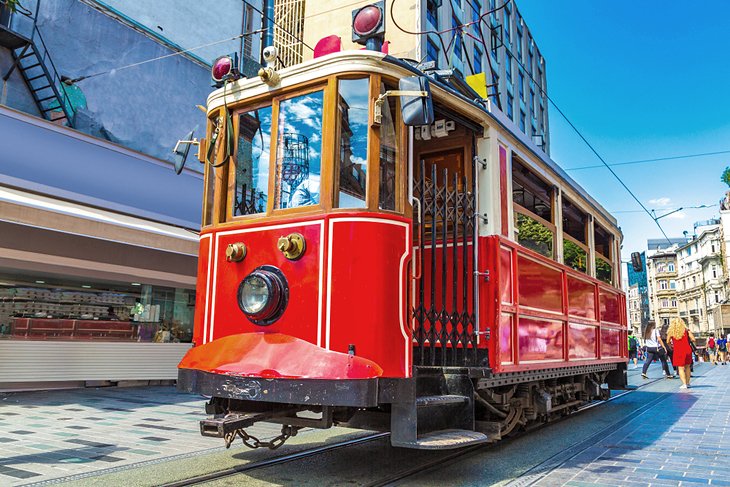
Highlights: Cafe-hopping, a historic tram ride, 19th-century façades, and a dining hub
Pedestrianized Istiklal Caddesi (Independence Street) is a bustling modern shopping street with a wealth of restaurants and cafés.
The lower end of the street can be reached by taking the world's oldest underground railway (the Tünel, constructed in 1875) from near Galata Bridge. There is also a quaintly old-fashioned tramway that runs along its length right up to Taksim Square at the top of the hill.
From Taksim Square, busy Cumhuriyet Caddesi is lined with hotels, shops, restaurants, and high rises. On the east side of the road, just after the square, is Maçka Park, which is home to the interesting Military Museum.
The area around Istiklal Caddesi is home to many churches and old consulate buildings with ornate facades.
Also nearby is Orhan Pamuk's Museum of Innocence. Pamuk is Turkey's most famous author and the winner of the Nobel Prize for Literature. This conceptual-art museum is based around the theme of his novel The Museum of Innocence and is a rather bizarre, kooky, and wonderfully atmospheric experience.
Address: Istiklal Caddesi
Explore the District of Üsküdar
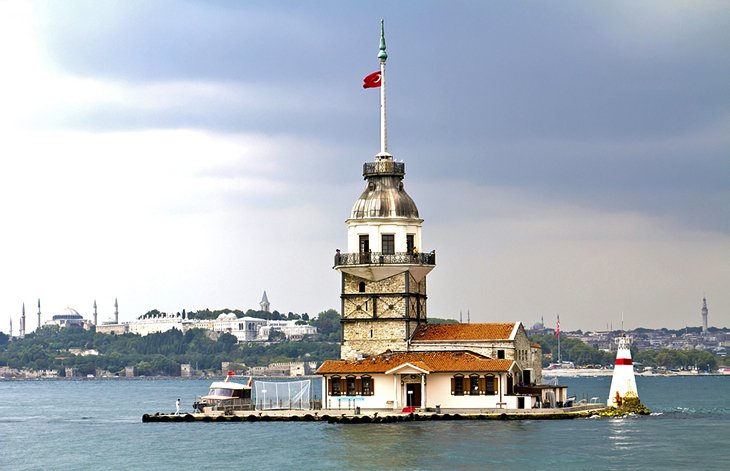
Highlights: Hillside strolls with city views and historic lesser-seen Ottoman mosques
Istanbul's Asian shore is easily reached by ferry from Eminönü dock across the Bosphorus.
On an islet just off the Asiatic shore stands the 30-meter-high Kızkulesi (Maiden's Tower).
Üsküdar was traditionally known as Scutari and has some handsome old mosques, winding lanes, and weathered brown timber houses (particularly between the ferry dock and the large cemetery).
The town, known in antiquity as Chrysopolis, was one of the earliest Greek settlements on the Bosporus.
It was much more exposed to attack by foreign conquerors than Constantinople, with its defensive situation and strong walls, but it was able to draw economic advantage from its exposed situation – until 1800 it was the terminus of the caravan routes that brought the treasures of the East to Constantinople and onwards to Europe.
Of particular sightseeing interest here is the Atik Valide Mosque, which was designed by the famed Ottoman architect Sinan; and the Çinili Mosque, which contains some beautiful Iznik tilework.
Map of Tourist Attractions & Things to Do in Istanbul
Istanbul, Turkey - Climate Chart
| Average minimum and maximum temperatures for Istanbul, Turkey in °C | |||||||||||
| J | F | M | A | M | J | J | A | S | O | N | D |
| 9 3 | 9 3 | 12 4 | 17 8 | 22 12 | 26 16 | 28 19 | 28 19 | 25 16 | 20 12 | 15 9 | 11 5 |
| PlanetWare.com | |||||||||||
| Average monthly precipitation totals for Istanbul, Turkey in mm. | |||||||||||
| 99 | 66 | 61 | 48 | 31 | 20 | 20 | 25 | 41 | 71 | 89 | 122 |
| Average minimum and maximum temperatures for Istanbul, Turkey in °F | |||||||||||
| J | F | M | A | M | J | J | A | S | O | N | D |
| 47 37 | 48 37 | 52 39 | 62 46 | 70 53 | 79 61 | 82 65 | 82 65 | 77 59 | 67 53 | 59 47 | 52 41 |
| PlanetWare.com | |||||||||||
| Average monthly precipitation totals for Istanbul, Turkey in inches. | |||||||||||
| 3.9 | 2.6 | 2.4 | 1.9 | 1.2 | 0.8 | 0.8 | 1.0 | 1.6 | 2.8 | 3.5 | 4.8 |
The best time to visit Istanbul is, in general, from late spring to early fall — the months of May, June, July, August, and September.
July and August are peak tourism season and bring the hottest weather with long summer days heralding plenty of blue skies and sunshine — great for fitting in plenty of sightseeing. Average temperatures in the city during this period vary between 20 and 29 degrees Celsius. T-shirt weather carries into the evenings for these months, meaning you can slim down your packing requirements.
If you're planning to travel in May, June, or September instead (which are still considered high season in Istanbul), daytime temperatures are usually thoroughly pleasant. For some visitors, its slightly milder temperatures are preferable to July and August for sightseeing, but you will need to pack a warmer layer to throw on after the sun sets. And, remember to bring along an umbrella, as May and September in particular can bring up to eight or nine rainy days per month.
More Related Articles on PlanetWare.com
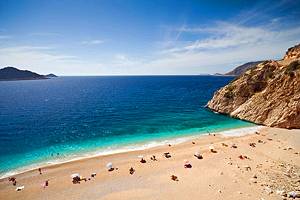
The Coast and More Historic Cities: After an Istanbul sojourn, why not hit Turkey's famed coastline, lapped by the waves of the Aegean and Mediterranean seas. Check out our articles on Bergama and the North Aegean, Fethiye, Antalya, and Kas for inspiration. Turkey has plenty of other historic cities to discover. Konya and Sanliurfa are two of the best and are city guides to these destinations can help you plan your time.




